Proper care of lavender in the fall and preparation for winter, transplantation of lavender - the key to the fact that the plant will tolerate the cold. There are certain nuances of what and how to cover it for the winter, when it is better to plant. The experience of specialists helps novice gardeners avoid mistakes and preserve lavender even at low temperatures.
Content
- 1 Features of lavender care in the fall
- 2 Pruning lavender in autumn
- 3 Topping lavender after pruning
- 4 How to keep lavender in winter
- 5 How to shelter lavender for the winter
- 6 Winter lavender shelter in the regions
- 7 Wintering potted species
- 8 Planting lavender in the fall
- 9 Lavender transplant in the fall
- 10 Beginner Errors
- 11 Tips for gardeners
- 12 Finally
Features of lavender care in the fall
Lavender is a capricious plant, so that it does not suffer from exposure to low temperatures, it is necessary to create the necessary conditions. Warm regions are perfect for her, therefore, in areas with a harsh climate before wintering, you must:
- loosen the soil around the bushes;
- thoroughly remove weeds;
- crop a flower;
- to make mineral fertilizers for top dressing;
- cover thoroughly for the winter.
For the active growth of lavender, it is necessary that the roots freely feed on incoming oxygen. To do this, loosening the soil. If the earth is dense, the procedure is carried out regularly during the season, while weed roots should be removed. So that they do not germinate again, you can fill the soil around the bushes with mulch from fallen leaves. To make the bushes look attractive, the leaves are replaced with decorative substrates, they are also useful.
The issue of watering is also relevant. The plant does not tolerate marshy soil. The amount of water should be moderate. Otherwise, the leaves of the flower begin to rot, turn yellow. With insufficient watering, it gradually dries. It is better to irrigate the area as it dries. Before wintering, lavender can be fed with potassium, phosphorus. The main dressing is performed in the spring. You can refuse to apply fertilizers if a special decorative substrate is spread around the bushes. In the process of its decomposition, mineral fertilizers that feed the plant's root system will fall into the soil.
Pruning lavender in autumn
Gardeners prune throughout the season and flowering period of the plant. This must be done so that buds that have already faded are replaced with new ones. It is necessary to carry out manipulation in the autumn period. There are a number of explanations for this, but the main task is to preserve the shrub for a long period.
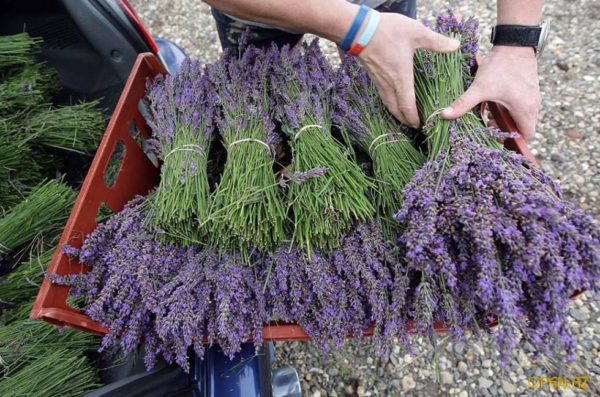
Do I need to cut lavender in the fall
Timely pruning before winter is necessary. The procedure allows you to save the plant in a compact form. Not all gardeners remove terrestrial shoots, explaining this by the desire to maintain the shape of the crown. After the snow falls, the plant will be densely covered from above and will not freeze even at low temperatures.
In regions where rainfall may be minimal, ground shoots may freeze due to wind and frost. When freezing, the trunks become brittle, they are easy to damage.The risk of developing plant diseases in precisely the broken parts increases. They can also be damaged by insects.
When to prune lavender in autumn or spring
Planting lavender and care in the open ground provide for pruning from the first spring months. The procedure is necessary to accelerate the onset of flowering. In addition, so the bush can be given the desired shape. These garden works can be carried out as soon as the risk of frost and the constant temperature are established.
Pruning can be radical. In this case, secateurs are removed third or half of the total volume of the bush. This is acceptable if the procedure was not performed in the fall. Sanitary removal of trunks that have suffered from frost and pests is also necessary. In autumn, all shoots that have bloomed should be carefully removed. Given all the nuances, there is no definite answer when it is better to trim: in autumn or spring. It is important throughout the season.
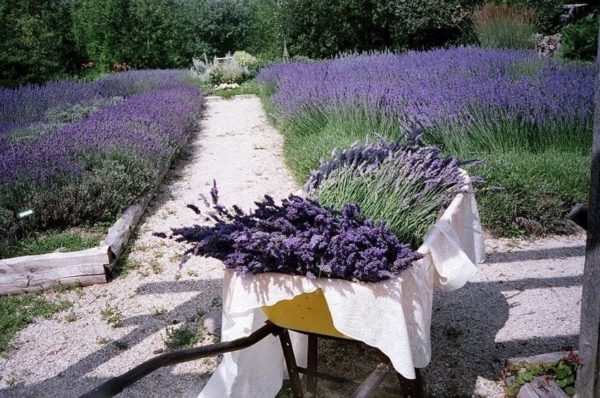
When and how to prune lavender in the fall
You can start pruning in autumn when the second flowering period of the plant has ended. In most cases, this happens in September. Excess shoots are removed to make it more convenient to cover the bush for the winter. It is necessary to leave the upper part 3 cm high. This will allow the plant to calmly tolerate the cold season and not suffer from subzero temperatures.
Circumcision is carried out in 2 stages. First, shoots should be removed to mid-height. Then anti-aging pruning is performed. The second part of the barrel is removed so that the desired height remains. So, the plant will not suffer, well overwinter.
Topping lavender after pruning
After pruning lavender, you need to feed. For the procedure, you can use any fertilizer that is sold in specialized flower shops. Fertilizer is diluted with water (2 tablespoons per 10 liters). Before top dressing, the earth needs to be well loosened and watered. If fertilizer is poured onto dry, uncultivated soil, the root system of lavender will not stand and burn.
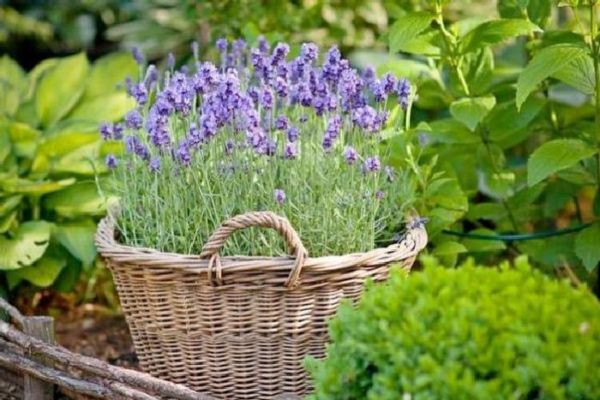
How to keep lavender in winter
Lavender grown In warmer areas, no need to protect from the cold. This is a frost-resistant plant that tolerates temperatures up to -25 degrees. In regions with a dry climate, it must be covered. If lavender grown in pots, then at the first cold snap it is transferred to a warm place, protected from cold drafts.
The most dangerous season for a flower is considered to be spring with its sharp changes in temperature - it is warm during the day and thermometer readings fall significantly at night. Snowy winter is considered a safer period.
How to shelter lavender for the winter
Protecting lavender from winter cooling is not so difficult if you follow a few simple recommendations.
- Snow should not fall inside the crown, so the bushes are well connected.
- The soil circle must be well insulated. It is not recommended to use ordinary fallen leaves, because in the course of their debate harmful microorganisms, fungi that can harm lavender are formed. Dry peat and needles are excellent for this purpose.
- The whole bush must be closed with branches of spruce or other conifers. The hut must be fixed with twine. The bush can be lightly buried under the ground. Spruce hut above abundantly covered with snow. If the snow has not fallen, the plant is unlikely to be able to withstand frost.
If lavender is grown in the northern regions, plywood boxes can be used to shelter it. On top of them you need to put a large number of spruce branches - this is necessary for better oxygen circulation, heat preservation.
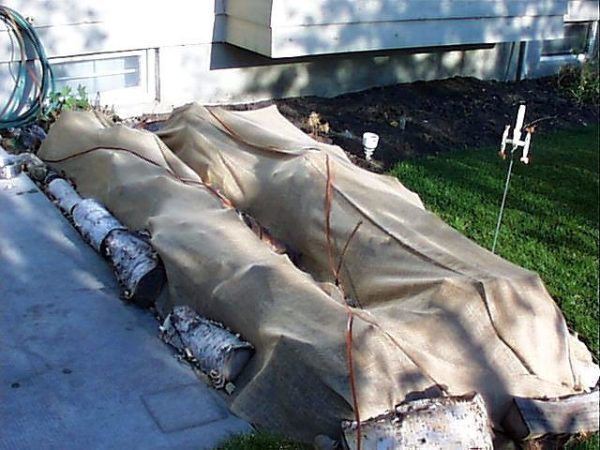
Winter lavender shelter in the regions
In each region, the preparation of lavender for wintering is different.This is due to climatic conditions - in some cities, winter is accompanied by an abundance of snow, winds, in others there may be no snow, the air is too dry and cold. To preserve the plant, it is important to take into account every nuance, otherwise the flower will die during the first frosts.
In the middle lane (Moscow region)
This region is characterized by the presence of severe frosts, however, most gardeners in the Moscow region prefer not to cover the plant for the winter. Autumn pruning is also not carried out - long trunks when tying, further falling asleep with snow, unlike other shelters, warm better, protecting from the cold.
Broadleaf lavender must be insulated with straw, hay, branches or peat. If the plant is grown in pots, it is cleaned in a warm room. If this is not done, they will die during the first frosts.
In the Volga region
In this region, winters are accompanied by severe frosts. Temperature may drop below -25 degrees. Such weather conditions are long, usually observed from two or more weeks. If low temperature is not accompanied by the presence of large snow cover, all seedlings will freeze. Therefore, lavender must be sheltered, providing it with good protection.
In the Urals and Siberia
These regions are characterized by severe winter cooling, the temperature here drops to below 35 degrees. To withstand such weather conditions, only narrow-leaved lavender (frost-resistant variety) is capable of. Trimming the plant is not recommended. Only a high shrub is able to withstand frost, while maintaining its root system.
In the Urals and Siberia, lavender shelter is required. To do this, use all available methods. Fits:
- sackcloth;
- agrofibre;
- spruce branches;
- lapnik.
Only good warming will allow the plant to survive the winter and in the spring it will begin to please with rapid growth, flowering and an unforgettable smell.
Wintering potted species
More and more gardeners plant lavender in pots and grow for landscape decoration, and use it in design to decorate terraces and balconies. An ornamental plant with proper care wintered well. In preparation for the cold, you should trim it, enrich the soil with the necessary amount of mineral fertilizers. It is forbidden to leave a potted plant in the fresh air for the winter. It will not tolerate the effects of low temperature, even if the shelter is created. Flower pots are best placed in a warm, heated room until spring.
Planting lavender in the fall
In regions with a warm climate, the flower is boldly planted in the fall. In winter, the temperature does not drop to critical values and the plant will not die. It is better to transplant a bush to residents of the middle lane in the spring. Pre-select the site. Lavender will not grow in wetlands. She also needs constant sunlight.
Not always there is a suitable plot in the garden, then it is better to create the required conditions artificially. To dry the soil a little to create an elevation, make a deepening and first fill it with drainage, expanded clay, then fill it with earth and plant flowers. During the autumn planting you need:
- create an elevation of 40 cm in the selected place;
- prepare pits for flowers with a depth of 25 cm;
- arrange them at a distance of 40 cm from each other;
- 60 minutes before planting in the soil, lower the roots of plants into the water;
- cut off the tops;
- during planting, additionally add mineral fertilizers to the soil.
If planted correctly lavender, it winters without problems. For complete rooting, the plant takes about 2 months. You can propagate the flower by dividing the mother bush. It should be dug up, divided using a knife. All sections must be treated with an antiseptic: charcoal, powdered activated carbon, powder of foundationazole. This will prevent the development of flower diseases, rotting of the root system.
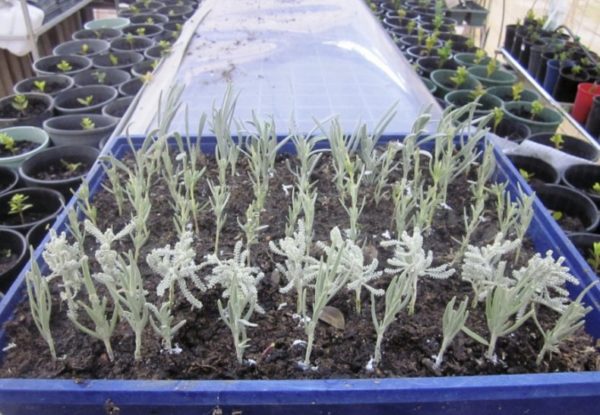
Landing methods
Planting flowers is necessary in pre-prepared wells.Their depth differs depending on the plant variety. An indicator of 25-30 cm is considered optimal. Single plants can be planted or groups of them can be formed. In this case, a distance of 40 cm should be left between the formed bushes. To make the row look thick, this figure is reduced on average by 2 times. Experienced gardeners prefer to form group plantings. With their help, it is easy to arrange a decorative border, make a carpet landing. Flowers grow well on high beds, in pots or flowerpots used to design the site, balcony.
Optimal time for landing
Planting plants is best in the spring. It is considered optimal for this. You should wait until the frost completely stops, the weather is warm. Residents of young regions can engage in such work in September and October. The climate is fully suitable. Before the planned cooling, the first frost should be at least 2 months.
Plant soil
The flower will not grow in swampy, heavy soil. Stagnant moisture is unacceptable to him. The root system rot begins immediately. A sandy, gravelly well-drained site is suitable for him. Moreover, the earth should not be overfilled with nutrients or suffer from their lack.
In some cases, gardeners independently prepare soil mixtures, filling them with pits prepared for planting. For optimal composition, mix:
- sheet earth;
- humus;
- sand.
Landing place
For planting a flower, you should choose a well-lit, hot area in the garden. This will contribute to the lush flowering of lavender, the active spread of a characteristic aroma. If the shady area is chosen as the landing site, the plant will rarely bloom; single buds can be observed.
The soil must be dry. Excess moisture adversely affects the growth, development of the plant. If necessary, elevation is best done artificially. An alpine slide is ideal for planting.
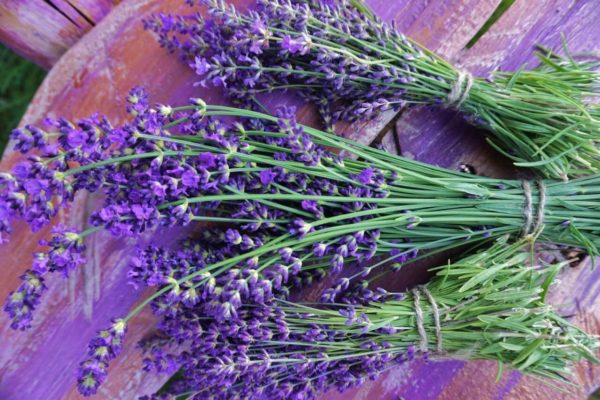
Lavender transplant in the fall
It is necessary to dig out a bush carefully, without damaging its root system. It is important that there remains a large lump of earth on it - this will help protect the roots from damage. It is recommended to engage in transplantation in late summer, early autumn, when the flowering period ends. Transplanting lavender in autumn is required if:
- there is no bush growth;
- need to change the place of plant growth;
- separation of one large bush into several small ones is required.
The root system of lavender, despite the small size of the plant, can penetrate deep into the soil by 4 meters. But this is not a hindrance during transplantation, since the bush easily tolerates such a procedure.
Beginner Errors
Out of ignorance of the rules for caring for the plant, mistakes can be made that will result in the death of the shrub or slow its growth. To prevent this and enjoy beautiful flowering, you should not:
- water abundantly and cut the flower strongly. Excess moisture will cause the horses to melt, and deep pruning will not allow the plant to fully recover;
- plant lavender in clogged ground, where there is a lot of clay, peat. In such soil, the roots will not be able to get the amount of oxygen necessary for growth and full development;
- quickly prune in spring. It is not worth immediately after the snow to actively cut the bushes, freeing from excess and dry tops.The flower wakes up for a long time, you need to bring it into proper form later, with the onset of heat;
- to cover the flower with polyethylene is a gross mistake that leads to the plant becoming rotten. By spring, most of the flowers will be completely lost.
If you exclude these common mistakes, lavender will tolerate cold well, delight with a magnificent color and will not cause trouble in leaving.
Tips for gardeners
The main problem that gardeners face is poor frost resistance of the bush. In the open ground, only narrow-leaved lavender easily survives, and only when preparing shelter for it. Ordinary leaves are not used for this. They may contain pests, pathogenic microflora, fungi develop. Wintering under the leaves will adversely affect the plant. For this purpose it is better to use coniferous spruce branches. They cover not only the plant, but also the root circle.
If lavender does not bloom, it means that the place for its cultivation was chosen incorrectly - it is too shaded. Also, the lack of growth can be a sign of overfeeding with nitrogen fertilizers. For good growth, it is important to loosen the soil, to destroy weeds. The proper watering, timely pruning, top dressing and preparation for wintering have a beneficial effect on the development of lavender.
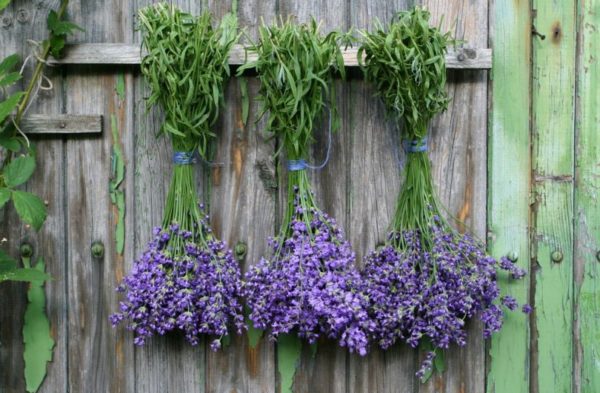
Finally
Proper care of lavender in the autumn, competent preparation for winter will save the plant. In the spring, of course, the bushes will not look presentable immediately after the snow has melted. The unsightly thickets will gradually move away, then you can begin to ennoble them. The capricious and demanding lavender needs constant supervision, but if everything is done correctly and in a timely manner, the result will be a bright flowering in the garden and a unique aroma spreading around.
